The Money Panic - US Banks Huge Exposures To Credit Risk
Stock-Markets / Financial Crash Dec 04, 2007 - 02:26 AM GMT Martin Weiss writes: With credit markets sinking into deeper turmoil ...
Martin Weiss writes: With credit markets sinking into deeper turmoil ...
With more severe losses spreading to a wider range of financial institutions ...
And with the Fed's rate cuts thus far failing to stem the crisis ...
We are coming dangerously close to a money panic.
Few Wall Street analysts are talking about this in public. Fewer still understand its potential consequences. Many don't even know what a money panic is. But historians do. They realize that ...
A money panic is a stampede from greed to fear, risk to safety, buying to selling. Once set into motion, it can spin out of control, feeding on itself, wrecking havoc in financial markets.
Moreover, the data I'll share with you in this in-depth issue shows that, if not averted, a money panic could ...
- Threaten the solvency of major Wall Street firms like Bear Sterns, Goldman Sachs, Lehman Brothers, Merrill Lynch or Morgan Stanley.
- Increase the risk of future failure among large banks like Bank of America, Citibank, HSBC, JPMorgan Chase or Wachovia.
- Even force certain kinds of money market funds to break their solemn process of preserving your capital.
No one can predict the future. But right now, the panic is already spreading from big brokers and banks to local governments and a few money market funds. Just last week, for example:
- Florida's Local Government Investment Pool , a fund for local Florida governments, was frozen to stop a rush of withdrawals by panicked investors. Until recently, the fund had $27 billion. Last month, it fell to $15 billion due to mortgage-related losses and mass withdrawals. And on Thursday morning alone, before Florida slapped the freeze on withdrawals, the fund lost $3.5 billion!
- Montana's school districts, cities and counties withdrew $247 million from the state's $2.4 billion investment fund after officials said the rating on one of the pool's holdings was lowered to "default" level.
- Countrywide Financial caused more shock waves. One week ago, I explained why I believe the company is on a collision course with bankruptcy. ( Click here for the details. ) Now, we learn that state funds like Florida's may have substantial investments in the company's banking subsidiary, downgraded in August and likely to be downgraded again.
Even certain money funds, thought to be safe from the turmoil, have felt repercussions. Bloomberg's David Evans puts it this way:
"Unbeknownst to most investors, some of the largest money market funds today are putting part of their cash into one of the riskiest debt instruments in the world: collaterized debt obligations (CDOs) backed by subprime mortgage loans ...
"U.S. money market funds run by Bank of America Corp., Credit Suisse Group, Fidelity Investments and Morgan Stanley held more than $6 billion of CDOs with subprime debt in June, according to fund managers and filings with the U.S. Securities and Exchange Commission. Money market funds with total assets of $300 billion have invested in subprime debt this year."
Some examples cited by Bloomberg:
- The Credit Suisse Group Institutional Money Market Fund Prime Portfolio held 8% of its $22.8 billion of assets in commercial paper secured by subprime home loans as of June 30.
- Two AIM money market funds owned $2.64 billion of CDO commercial paper that was invested in subprime debt, also in June.
- Fidelity Investments , the world's biggest mutual fund company, owned $2.3 billion in CDO-issued commercial paper in two money market funds as of May 31.
- Fidelity Cash Reserves Fund , the biggest money market fund in the U.S., had 1.5% of its $98.2 billion of assets invested in CDO commercial paper backed by subprime debt.
- The Fidelity Institutional Money Market Portfolio had 2.3% of its $32.3 billion in assets such as commercial paper.
- Federated Investors , the third-largest U.S. manager of money market funds, had seven money market funds with a total of more than $1 billion of commercial paper issued by Bear Stearns-managed CDOs at the end of June.
- Bank of America's Columbia Cash Reserves and Columbia Money Market Reserves funds owned more than $600 million of Bear Stearns' CDOs. And ...
- Wells Fargo runs three money market funds which held a total of $1.5 billion in CDO commercial paper, also on June 30.
To their credit, some of these funds have since trimmed their riskier holdings. But the above list barely scratches the surface. Looking ahead, money funds like these will either ...
(a) have to dump their mortgage-backed securities, driving down the market value of those investments even further. Or worse ...
(b) get stuck with these sinking investments and let their own shares break below the $1-per-share price that's mandatory for a money fund's survival.
Right now, the companies that manage the money funds are stepping in to inject capital and prevent this potentially disastrous break-the-buck scenario. But they are under no legal obligation to do so. And if they don't ... that's when you could see a full-fledged money panic unfold.
In a moment, I'll name some money funds that are not vulnerable. But first, let me explain why I believe this particular panic is so unique.
Close Encounters with a Panic of the Third Kind

I first began studying the history of financial panics nearly four decades ago, when I was an undergraduate at New York University.
I learned about the panics of 1833, 1837 and 1857, which were the result of speculative land booms stimulated by the westward advance of the nation's first railroads.
I studied the panic of 1901, the outcome of a battle to corner the stock market and take over the Northern Pacific Railroad.
I delved into the "rich man's panic" of 1907, which followed a boom in corporate mergers ... the 1920-21 panic precipitated by the liquidation of excess business inventories ... plus the 1929 panic that came with the unraveling of a huge stock market pyramid built by brokers, banks, industrial tycoons and speculators.
And from my graduate student dorm at Columbia University, I even published a book dedicated to this subject.
I found that history has brought us two kinds of panics:
1. Panics brought on by a collapse of assets with liquid markets — such as stocks, bonds and certain commodities.
2. Panics caused mostly by the collapse of assets without liquid markets — such as business inventories, land or locomotives.
Today, there's no evidence that these 19th or 20th century-type panics will be repeated. Too much — especially the active intervention of central banks — has changed since then. But there is abundant evidence that we are now experiencing close encounters with a money panic of a third kind.
Indeed, according to banking regulators, there are three kinds of assets in the world:
Level One assets are actively traded. You can know exactly how much they're worth based simply on their price in the open market.
Level Two assets are not actively traded. But they're similar enough to actively traded assets to give you a reasonable estimate of their value.
Level Three assets are the most slippery. In addition to having no active market, they're so unique, there's no reliable way to estimate their true value. Instead, all that banks and regulators can do is guess. And the only tools they have to support their guesswork are unproven mathematical formulas.
Here's the key:
The money panic brewing today is driven largely by this third kind of asset — derivatives of questionable value that were artificially created by Wall Street brokers, officially sanctioned by Washington regulators, and falsely rated by Wall Street rating agencies .
These are the sinking assets that are hitting the big Wall Street firms ... panicking investors in Florida and Montana ... even threatening some money market funds.
The irony:
Everyone finally recognizes that these assets are collapsing. But since there's no way of measuring their value until after they're dumped on the market, no one can possibly know how bad that collapse really is until it's too late.
Think of it this way: You own General Motors. You check its share price daily. And you see it's sinking in value. You may decide to tolerate the loss and continue to monitor the situation closely. Or you may decide to cut your loss and get out. Either way, at least you know how much damage it's doing to your portfolio.
But now, let's say you own some of these hard-to-name, impossible-to-value CDOs that are causing so much grief to investors today. You can't find it on the Web. You can't ask your broker what's happening. The only way you can determine its value is to take the plunge and dump it on the market at whatever price it'll fetch.
That's the situation investors are facing with level three assets right now:
Thousands of local governments, banks and individuals have no idea of exactly when, where or how much they're losing. And it is this unusual level of uncertainty that's creating the conditions for a money panic.
What about the Treasury's efforts to freeze that rate of interest on these investments in order to help millions of homeowners avoid foreclosure? That just adds still more uncertainty, throwing not only the value but also the yield on these securities into question.
Look. I've been screaming "Bloody murder!" about these assets since they were first created. My father did the same before me. But no one would listen. And now, I'm concerned that it could be too late.
Some of Wall Street's Largest Firms Have More Level Three Assets Than They Have Capital
Specifically, according to data compiled by the Financial Times :
Merrill Lynch has $27.2 billion in level three assets, the equivalent of 70% of its stockholders' equity. In other words, for each $1 of its capital, Merrill has 70 cents in assets of questionable and uncertain value.
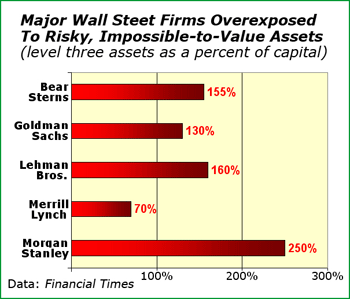
Goldman Sachs has $51 billion in level three assets, or 130% of its equity.
Bear Sterns has sunk its balance sheet even deeper into the level-three-asset hole, with $20.2 billion, 155% of its equity.
Lehman Brothers is in a similar situation — $34.7 billion, or 160% of its equity. And ...
Morgan Stanley tops them all with $88.2 billion in level three assets, or 250% of its capital. That's an unwieldy $2.50 cents in level three assets for each dollar of capital. It implies that, in the absence of new capital infusions, all it would take is a 40% loss — and Morgan Stanley's capital could be 100% wiped out.
Bottom line: The huge Wall Street write-downs you've heard about to date — among the largest in history — could be just the tip of the iceberg.
Major U.S. Banks Are Also Overloaded With Derivatives
Derivatives are bets — sometimes good bets, sometimes bad ones. And the mortgage-backed securities that are ground zero of this crisis are also derivatives. But they're not the only derivatives that could be vulnerable.
My forecast: There are two kinds of derivatives that I believe could be directly impacted by a money panic:
- Interest-rate derivatives. If you think interest rates are going down, you could use these to take one side of the bet. If you think rates are going up, you could use them to take the other side.
- Credit-swap derivatives. If you think a particular borrower is relatively secure, you'd use these to take one side of the bet. Or if you think the borrower is likely to default, you'd take the other side.
The worrisome reality, according to the U.S. Office of the Comptroller of the Currency (OCC):
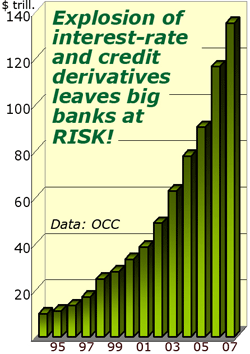
The rate of growth in these derivatives has been explosive.
At the end of 1994, the total "notional" value of interest-rate and credit derivatives held by U.S. banks was $9.9 trillion. And at the time, I thought that was a lot.
But as of the latest reckoning (June 30, 2007), it was $135.1 trillion, or 13.6 times more!
That's a growth of 1,260% in a huge-but-esoteric investment area that I think could be at the core of a money panic.
And it gets worse:
All told, there are 968 U.S. commercial banks that invest in derivatives. But among them, 963 banks hold a meager 1.5% of all the interest-rate and credit derivatives in America.
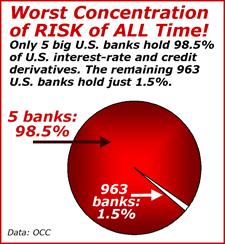
In contrast, just five banks hold an amazingly large 98.5% of all the interest-rate and credit derivatives.
From all my studies of history, I find that to be the worst concentration of risk of all time.
The five banks: JPMorgan Chase, Bank of America, Citibank, Wachovia and HSBC. How much risk are they taking? No one knows for sure. But therein lies one of the primary problems.
Yes, we know that not all derivatives are risky.
And yes, we know that the huge "notional" values of the derivatives can overstate their size.
But we also know that the formulas and models used to evaluate their risk levels may not hold up under panicky market conditions.
So although most derivatives can be accurately priced right now, they may be impossible to price in a money panic, much like level three assets.
Huge Exposures To Credit Risk
Helping to cut through some of the uncertainty, the OCC evaluates the credit exposure of each U.S. bank holding derivatives. In other words, it asks the question:
Regardless of whether the bet is a win or a loss, what happens if the investor on the other side of the bet doesn't pay up?
In normal times, such payment defaults are rare. So this is largely a theoretical question. But in a money panic, when markets can go haywire and available cash financing can suddenly dry up, a chain reaction of defaults could make this a very urgent and practical question.
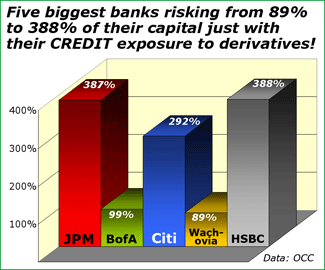
Here are the answers, according to OCC data:
Overall, including all types of derivatives ...
Wachovia has credit exposure that's equivalent to 89% of its capital. In other words, if all of its counterparties defaulted on their bets with Wachovia, nearly nine-tenths of its capital would be wiped out.
Bank of America is exposed to the tune of 99% of its capital. Assuming no capital infusions, it could be virtually wiped out in an extreme money panic scenario.
And at three banks, the panic would not have to be quite that extreme:
- Citibank has 292% of its capital exposed to this kind of credit risk.
- JPMorgan Chase has 387% of its capital exposed.
- HSBC beats them all with an exposure of 388% of its capital. That means that even if its counterparties defaulted on just 26% of their bets, its capital could be wiped out.
Now, remember what I told you about level three assets — that they don't have a regular place to trade.
Well, we could say something similar about the overwhelming majority of derivatives: They are not traded on regulated exchanges. Rather, they are traded over the counter, based on individually negotiated contracts.
In other words, if there's a default, the parties have to work through it directly, one on one. Exchange authorities are not going to step in to help manage the crisis for them.
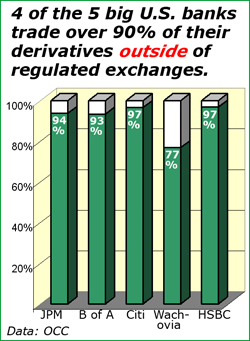
And currently, four of the five U.S. banks I named earlier trade over 90% of their derivatives in this way — outside of regulated exchanges.
At JPMorgan Chase, Bank of America, Citibank and HSBC, the derivatives they trade outside of exchanges represent 94%, 93%, 97% and 97% of their total, respectively. Only Wachovia has a somewhat lesser amount in this category — 77%.
End result: Still more uncertainty, still more vulnerability to a money panic.
Coming Tuesday, December 11: The Fed's Next Belated Response
Fed Chairman Bernanke and his colleagues don't talk about a panic in plain daylight. They dare not even utter the word. But I have little doubt that, behind closed doors, they're talking — and thinking — about it long past the bedtime of most investors.
They know all about last week's panic withdrawals from the Florida and Montana funds.
They know about the surprisingly large losses at some money funds.
They are aware of the collapsing and uncertain value of level three assets ... the big exposure to these assets at major Wall Street firms ... and the grave uncertainty revolving around trillions of dollars in derivatives.
They're not going to let the financial markets slide into a money panic without a fight. Quite the contrary, next Tuesday, December 11, the Fed is going to:
- Slash the discount rate by a quarter or even a half point ...
- Cut their target rate for short-term interbank borrowings (Fed funds), also by a quarter or a half point ...
- Restate, even more firmly, their readiness to do whatever it takes to avert a money panic, and ...
- Even come up with some new, creative ways to pump desperately needed cash into institutions likely to suffer the brunt of a money panic.
For the U.S. economy, already sinking into recession, I think it will be too little, too late.
But for the U.S. dollar, it will be too much, too soon. Its value will plunge anew. Foreign currencies — especially crisis currencies like the Japanese yen — will surge still further.
Three Ways to Escape A Money Panic
There is no investment that is absolutely safe from all dangers. But in this flammable environment, there are three you should consider very seriously:
Money Panic Escape Vehicle #1. Treasury-only money funds such as:
- American Century's Capital Preservation Fund ,
- U.S. Global's U.S. Treasury Securities Cash Fund , or
- Our affiliate's Weiss Treasury Only Money Market Fund .
These funds have never owned — and never will own — level three or even level two assets. They invest exclusively in the highest level, most secure assets in the world — short-term U.S. Treasury securities or equivalent.

When my father, J. Irving Weiss, founded the precursor to today's money funds in the early 1960s, this is precisely the kind of money fund he had in mind. And today, I'm pleased to see there are quite a few still following that model.
The only risk, as I see it: The sinking value of the dollar itself. But you can offset that risk with ...
Money Panic Escape Vehicle #2. As Jack and I explain in our free 50-minute video online right now , the world's paramount "crisis currency" is the Japanese yen. And now, you can conveniently buy Japanese yen through ETFs or even options, aiming for returns of as much as 28 to 1.
Money Panic Escape Vehicle #3. Gold. The daily market price is bound to fluctuate sharply. But with the threat of a money panic ... and with central banks rushing to counter that threat by printing more paper money ... the yellow metal is likely to make the $800-per-ounce level a floor and head for much higher levels.
Good luck and God bless!
Martin
This investment news is brought to you by Money and Markets . Money and Markets is a free daily investment newsletter from Martin D. Weiss and Weiss Research analysts offering the latest investing news and financial insights for the stock market, including tips and advice on investing in gold, energy and oil. Dr. Weiss is a leader in the fields of investing, interest rates, financial safety and economic forecasting. To view archives or subscribe, visit http://www.moneyandmarkets.com .
Money and Markets Archive |
© 2005-2022 http://www.MarketOracle.co.uk - The Market Oracle is a FREE Daily Financial Markets Analysis & Forecasting online publication.
Comments
|
Alan
25 Sep 08, 15:45 |
Prescience!
dated dec last year, quite prescient! |



